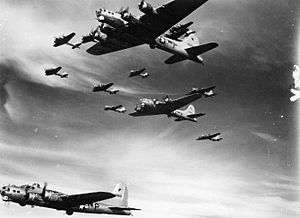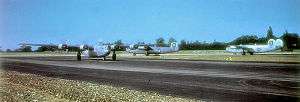863d Bombardment Squadron
The 863d Bombardment Squadron is a former United States Army Air Forces unit. It was first organized as the 518th Bombardment Squadron in October 1942, when it replaced a National Guard unit participating in antisubmarine patrols off the Atlantic coast, becoming the 13th Antisubmarine Squadron in November.. When the Navy took over the coastal antisubmarine mission in August 1943, the squadron moved to the western United States, where it formed the cadre for the 493d Bombardment Group and was redesignated as the 863d. It moved to England in the spring of 1944 and participated in the strategic bombing campaign against Germany until April 1945. It returned to the United States and was inactivated in August 1945.
| 863rd Bombardment Squadron | |
|---|---|
 493d Bombardment Group B-17 Flying Fortress formation | |
| Active | 1942-1945 |
| Country | |
| Branch | |
| Role | heavy bomber |
| Part of | Eighth Air Force |
| Engagements | European Theater of Operations |
| Insignia | |
| 863d Bombardment Squadron emblem (approved 13 May 1943)[1] |  |
History
Antisubmarine warfare
.jpg)
The squadron was first activated at Grenier Field, New Hampshire as the 518th Bombardment Squadron on 18 October 1942, when the 377th Bombardment Group replaced the 59th Observation Group at Fort Dix Army Air Field, New Jersey, and assumed its mission, personnel and equipment. The 518th was formed with the personnel and North American O-47s of the 119th Observation Squadron, which was simultaneously inactivated.[2] It converted to North American B-25 Mitchells the following year.[1][3][4] The squadrons of the 377th Group were at various bases along the coast between Delaware and New Hampshire.[5]
In October 1942, the Army Air Forces organized its antisubmarine forces into the single Army Air Forces Antisubmarine Command, which established the 25th Antisubmarine Wing the following month to control its forces operating over the Atlantic.[6][7] Its bombardment group headquarters, including the 377th, were inactivated and the squadron, now designated the 13th Antisubmarine Squadron, was assigned directly to the 25th Wing.[1][3] In July 1943, the AAF and Navy reached an agreement to transfer the coastal antisubmarine mission to the Navy. This mission transfer also included an exchange of AAF long-range bombers equipped for antisubmarine warfare for Navy Consolidated B-24 Liberators without such equipment.[8]
Training as a heavy bombardment unit in the United States
In September 1943, the 518th moved to Pueblo Army Air Base, Colorado, where it became part of Second Air Force. On 1 November 1943, the squadron was redesignated as the 863d Bombardment Squadron and Second Air Force moved it to McCook Army Air Field, where it formed the cadre for the 493d Bombardment Group.[1][9] At the beginning of January, the squadron transferred on paper to Elveden Hall, England. The ground personnel of the squadron in the United States had been used to form Boeing B-29 Superfortress units being activated by Second Air Force, while the air echelon remained in Nebraska to conduct training on their assigned Consolidated B-24 Liberators. Meanwhile, Eighth Air Force formed a new ground echelon for the squadron in England from other units assigned to the 3d Bombardment Division. This ground echelon moved to the squadron's combat station, RAF Debach, in April 1944. The squadron's air echelon departed for England via the northern ferry route on 1 May, while a small ground component left McCook and sailed from Boston, Massachusetts on the SS Brazil (1928) on 12 May 1944.[9][10]
Combat in the European Theater

The squadron flew its first combat mission on D-Day, 6 June 1944. It continued to fly Liberators until 24 August 1944, when it was withdrawn from combat to convert to Boeing B-17 Flying Fortresses, along with other units of the 93d Bombardment Wing, as Eighth Air Force concentrated all its Liberators in the 2d Bombardment Division. It resumed combat missions with the B-17 on 8 September 1944.[10] The squadron concentrated its attacks on military and industrial targets in Germany, attacking an ordnance depot in Magdeburg, factories near Frankfurt, and a synthetic oil manufacturing plant at Merseburg. It also attacked lines of communications, including a railroad tunnel at Ahrweiler, bridges at Irlich, and marshalling yards near Cologne.[9]
The squadron was occasionally diverted from the strategic bombing campaign to attack tactical targets. It supported Operation Overlord, the Normandy invasion, striking artillery batteries, airfields and bridges. It struck enemy ground forces south of Caen and during Operation Cobra, the breakout at St Lo. It bombed German fortifications to support Operation Market Garden, airborne attacks attempting to secure a bridgehead across the Rhine in the Netherlands, and attacked communications during the Battle of the Bulge. Toward the end of the war, it also supported Operation Varsity, the airborne assault across the Rhine in Germany.[9]
The squadron flew its last combat mission against marshalling yards near Nauen on 20 April 1945, although it flew food-dropping missions in early May.[10] The squadron air echelon departed Debach on 30 June, while the ground echelon sailed for home aboard the RMS Queen Elizabeth on 6 August 1945. In late August, the squadron assembled at Sioux Falls Army Air Field, South Dakota, where it was inactivated on 28 August 1945.[1][9]
Lineage
- Constituted as the 518th Bombardment Squadron (Heavy) on 13 October 1942
- Activated on 18 October 1942
- Redesignated: 13th Antisubmarine Squadron (Heavy) on 29 November 1942
- Redesignated: 863d Bombardment Squadron, Heavy on 1 November 1943
- Inactivated on 28 August 1945[1]
Assignments
- 377th Bombardment Group (attached to Army Air Forces Antisubmarine Command), 18 October 1942
- 25th Antisubmarine Wing, 9 December 1942
- Second Air Force, 22 September 1943
- 493d Bombardment Group, 1 November 1943 – 28 August 1945[1]
Stations
- Grenier Field, New Hampshire, 18 October 1942
- Pueblo Army Air Base, Colorado, 22 September 1943
- McCook Army Air Field, Nebraska, 1 November 1943 – 1 January 1944
- Elveden Hall (Station 116),[11] England, 1 January 1944
- RAF Debach (AAF-152),[11] England, 17 April 1944 – 6 August 1945
- Sioux Falls Army Air Field, South Dakota, c. 13–28 Aug 1945[12]
Aircraft
- North American O-47, 1942–1943
- North American B-25 Mitchell, 1943
- Consolidated B-24 Liberator, 1943–1944
- Boeing B-17 Flying Fortress, 1944–1945[1]
Campaigns
| Campaign Streamer | Campaign | Dates | Notes |
|---|---|---|---|
| Antisubmarine | 18 October 1942–1 August 1943 | 518th Bombardment Squadron (later 13th Antisubmarine Squadron)[1] | |
| Air Combat, EAME Theater | 1 January 1944–11 May 1945 | 863d Bombardment Squadron[1] | |
| Normandy | 6 June 1944–24 July 1944 | 863d Bombardment Squadron[1] | |
| Northern France | 25 July 1944–14 September 1944 | 863d Bombardment Squadron[1] | |
| Rhineland | 15 September 1944–21 March 1945 | 863d Bombardment Squadron[1] | |
| Ardennes-Alsace | 16 December 1944–25 January 1945 | 863d Bombardment Squadron[1] | |
| Central Europe | 22 March 1944–21 May 1945 | 863d Bombardment Squadron[1] |
See also
References
Notes
- Maurer, Combat Squadrons, pp. 786-787
- Maurer, Combat Squadrons, p.590
- Maurer, Combat Units, pp. 265-266
- Maurer, Combat Units, p. 123
- Maurer, Combat Squadrons, pp.75, 785-786
- Maurer, Combat Units, p. 437
- Maurer, Combat Units, pp. 388-389
- Ferguson, pp. 82-83
- Maurer, Combat Units, pp. 362-363
- Freeman, p. 262
- Station number in Anderson.
- Station information in Maurer, Combat Squadrons, pp. 786-787, except as noted.
Bibliography
![]()
- Anderson, Capt. Barry (1985). Army Air Forces Stations: A Guide to the Stations Where U.S. Army Air Forces Personnel Served in the United Kingdom During World War II (PDF). Maxwell AFB, AL: Research Division, USAF Historical Research Center. Archived from the original (PDF) on 23 January 2016. Retrieved 28 June 2017.
- Ferguson, Arthur B. (April 1945). "The Antisubmarine Command, USAF Historical Study No. 107" (PDF). Assistant Chief of Air Staff, Intelligence Historical Division. Retrieved 12 September 2016.
- Freeman, Roger A. (1970). The Mighty Eighth: Units, Men and Machines (A History of the US 8th Army Air Force). London, England, UK: Macdonald and Company. ISBN 978-0-87938-638-2.
- Maurer, Maurer, ed. (1983) [1961]. Air Force Combat Units of World War II (PDF) (reprint ed.). Washington, DC: Office of Air Force History. ISBN 0-912799-02-1. LCCN 61060979.
- Maurer, Maurer, ed. (1982) [1969]. Combat Squadrons of the Air Force, World War II (PDF) (reprint ed.). Washington, DC: Office of Air Force History. ISBN 0-405-12194-6. LCCN 70605402. OCLC 72556.
\
